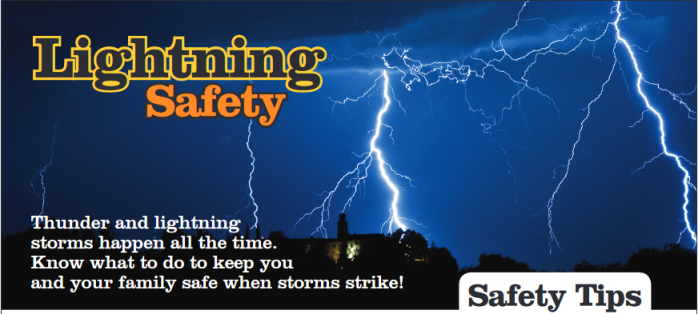Learn indoor and outdoor safety tips to protect yourself and your loved ones from lightning.

Go Indoors.
Remember the phrase, “When thunder roars, go indoors.” If you hear thunder, you are within striking distance of lightning. Find a safe, enclosed shelter when you hear thunder. Safe shelters include homes, offices, shopping centers, and hard-top vehicles with the windows rolled up. Wait at least 30 minutes after hearing the last clap of thunder before leaving your shelter.
Indoor Safety Tips
Even though your home is a safe shelter during a lightning storm, you might still be at risk. About one-third of lightning-strike injuries occur indoors. Here are some tips to keep safe and reduce your risk of being struck by lightning while indoors.
Avoid water.
Do NOT bathe, shower, wash dishes, or have any other contact with water during a thunderstorm because lightning can travel through a building’s plumbing. The risk of lightning traveling through plumbing might be less with plastic pipes than with metal pipes. However, it is best to avoid any contact with plumbing and running water during a lightning storm to reduce your risk of being struck.
Don’t touch electronic equipment.
Do NOT use anything connected to an electrical outlet, such as computers, laptops, game systems, washers, dryers, or stoves. Lightning can travel through electrical systems, radio and television reception systems, and any metal wires or bars in concrete walls or flooring. Equip your home with whole-house surge protectors to protect your appliances.
Avoid windows, doors, porches, and concrete.
Stay away from windows and doors, and stay off porches. Do NOT lie on concrete floors or lean on concrete walls during a thunderstorm. Lightning can travel through any metal wires or bars in concrete walls or flooring.
Don’t use corded phones.
Corded phones are NOT safe to use during a thunderstorm. Do NOT use them. However, it is safe to use cordless or cellular phones during a storm.
Outdoor Safety Tips
Although no place outside is safe during a thunderstorm, you can minimize your risk by assessing the lightning threat early and taking appropriate actions. The best defense is to avoid lightning. Here are some outdoor safety tips that can help you avoid being struck by lightning.
Be aware.
Check the weather forecast before participating in outdoor activities. If the forecast calls for thunderstorms, postpone your trip or activity, or make sure suitable safe shelter is readily available.
Seek shelter immediately, even if caught out in the open.
If you are caught in an open area, act quickly to find shelter. The most important action is to remove yourself from danger. Crouching or getting low to the ground can reduce your chances of being struck, but it does not remove you from danger.
Avoid open spaces.
Immediately get out and stay away from open spaces such as golf courses, parks, playgrounds, ponds, lakes, swimming pools, and beaches. Get off of elevated areas such as hills, mountain ridges, or peaks.
Don’t stay in open vehicles.
During a thunderstorm, avoid open vehicles such as convertibles, motorcycles, and golf carts.
Don’t stay in open structures.
Avoid open structures such as porches, gazebos, baseball dugouts, and sports arenas. These structures won’t protect you from lightning.
Don’t stay near tall structures.
Avoid anything tall or high, including rooftops, scaffolding, utility poles, cell phone towers, ladders, trees, and large equipment, such as bulldozers, cranes, and tractors. Lightning tends to strike the tallest object around.
If you are out in the open water and a storm rolls in, return to shore immediately.
If you are on a boat in open water when a thunderstorm rolls in, return to shore immediately and seek shelter. If you are unable to return to shore, boats with cabins offer some protection. If caught in a storm in a small boat with no cabin, drop anchor and get as low as possible.
Stay away from objects that conduct electricity (such as barbed wire fences, power lines, or windmills). Do NOT touch materials or surfaces that conduct electricity, including metal scaffolding, metal equipment, utility lines, water, water pipes, or plumbing.

People Who Work Outside are at Higher Risk
People at greatest risk of being struck by lightning are those who work outdoors in open spaces, on or near tall objects, or near materials that conduct electricity or engage in outdoor recreational activities.
The following occupations have the highest risk of lightning strikes:
- Construction and building maintenance
- Roofing
- Heavy equipment operation
- Pipe-fitting or plumbing
- Power utility field repair
- Landscaping
Take Steps to Protect Yourself
Check the forecast – (install a weather alert app on your cell phone)
Know the daily weather forecast so you are prepared and know what weather to expect during the day.
Watch for signs of potential lightning strikes
Pay attention to early weather signs of potential lightning strikes, such as high winds, dark clouds, or distant thunder or lightning. When these occur, don’t start any activity that you can’t quickly stop. Lightning may strike as far as 10 miles from any rain. Wait at least 30 minutes after hearing the last clap of thunder before leaving your shelter.
First aid
If your coworker is struck by lightning, call 911. Immediately begin first aid, if necessary. People who have been struck by lightning DO NOT carry an electrical charge and can be handled safely.
Resources:
https://www.cdc.gov/disasters/lightning/safetytips.html; https://www.weather.gov/media/owlie/OSHA_FS-3863_Lightning_Safety_05-2016.pdf; https://www.nfpa.org/-/media/Files/Public-Education/Resources/Safety-tip-sheets/Lightning_Safety.ashx
